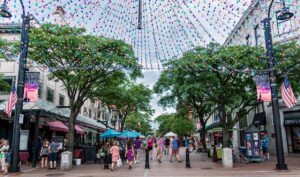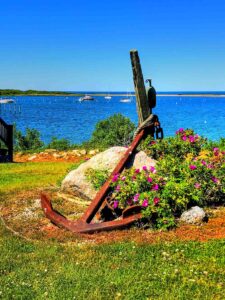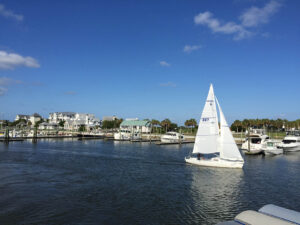Cape May, New Jersey has long been known as a birding hotspot among land-dwellers, sporting some amazing statistics of spring and fall migration. Over 40,000 hawks, eagles and falcons are counted each year from the Hawkwatch at the Cape May Point State Park, and over a million waterbirds were counted from the Avalon Seawatch between September 22 and December 22, 2014.
These migration watches have been staffed by New Jersey Audubon’s Cape May Bird Observatory for nearly four decades and are a popular site to visit each year. What might not be as obvious are the myriad opportunities for boaters visiting the Cape May area to get up close and personal with local wildlife.
No Such Thing As A Seagull
While there is no such species as a Seagull there are many species of gull inhabiting areas. With a little practice, you’ll soon realize that you can identify a number of them when you enter Cape May from the ocean. Cape May is the largest breeding colony of Laughing Gulls in the world. This colony extends throughout the Intercostal Waterway from Cape May to Avalon and holds between 40,000 and 60,000 laughing gulls. While their winter plumage can be rather drab, when they’re all decked out in their spring and summer finery, there really is no other more beautiful gull. A gorgeous black hood, red bill, red legs, and white “eyeliner,” these gulls are purely spectacular.
Other breeding gulls in the area belong to the white-headed gull complex, namely the herring gull and great black-backed gull, the latter of which is the largest gull in the world, with the adult birds at least easily told by their jet-black backs. Adult herring gulls, in contrast, sport light gray backs, black wingtips, and a bold yellow bill. You can find them in the Cape May harbor, and you’re likely to spot one perched on a piling or during your land excursions to the numerous sandy beaches on the peninsula.
Come into Cape May from the southwest during a falling tide, and you’ll undoubtedly notice the activity of birds in the rips, as gulls and terns feed voraciously on the small fish present where the brackish waters of the Delaware River meet the saline waters of the Delaware Bay and Atlantic. While possible to identify birds in the rips from land, birding by boat has a clear advantage. Several species of tern are regular in the rips, including the smallest, the least tern. The two medium-sized terns present in large numbers are Forster’s and common. The larger terns are royal and Caspian, the latter being the largest tern in the world. All of these species breed on the Cape May peninsula, although some travel miles just to feed in the rips and bring their bounty back to their nests in the back bays.
The Bird With The Orange Cigar
Another species regularly encountered by boat, either when coming through the Cape May inlet or when cruising around the point, is the American oystercatcher. Often seen perched on the groins around the point, at the end of the 2nd Avenue Jetty or flying in pairs between the beaches and back bay marshes, these birds have serious character! Their melodious “pipping” call can be heard sometimes before you see them — but when you do lay eyes on them, they’re unmistakable: long, thick, bright orange bill and matching eye ring, black head and bib, white belly, flesh-pink legs and black and white wings in flight.
The oystercatcher gets its name from its propensity to feed on bivalves, splitting them open with its strong beak, either shucking them like we do oysters, or by pounding them like a woodpecker until it cracks the shell. These comical birds nest both on the sandy beaches of Cape May and in the back bay marshes, and your chances of seeing them are very good during the spring and summer.
The Comeback Kid
It wasn’t long ago when the osprey was practically extirpated from New Jersey. Through the banning of the pesticide DDT and the hard work of many dedicated individuals, the osprey has made a comeback. In fact, in 1973, there were only 53 nesting pairs in New Jersey, in contrast to 2013, with a record of over 500 nests found and monitored. Today most boaters know what an osprey platform looks like — a wooden tower in the marshes of New Jersey, topped by a platform and typically occupied by a large nest made of sticks. Osprey leave the area in the winter, heading south to areas with richer food resources, but come spring, the ospreys return, and they cash in on their homestead claims. Boaters entering the Cape May Harbor in the spring and summer months would be hard pressed to miss the ospreys breeding there. Again, as boats provide a perfect blind for wildlife viewing, it’s common to float passed an osprey platform in late summer and see the young chicks poking their heads above the rim of the nest to check out what’s going on in the world around them. It really is a special thing to witness, especially in light of the fact the species was on the brink of extirpation from New Jersey and across the eastern U.S. only forty years ago.
After docking at the South Jersey Marina (609-884-2400, southjerseymarina.com) or Canyon Club Resort Marina (609-884-0199, canyonclubmarina.com), come ashore and explore the docks for little harlequin shorebirds, the ruddy turnstone, as they pick and probe at the flotsam brought ashore by fishermen and pleasure boaters alike. Stop by New Jersey Audubon’s Nature Center of Cape May (609-884-2736, njaudubon.org) across the harbor, and pick up a copy of “Birding for Boaters,” then hop in a kayak available for rent next door and head out to explore either on your own or with an expert guide. If you want a more personalized birding adventure, come by New Jersey Audubon’s Cape May Bird Observatory on East Lake Drive, Cape May Point, for a full roster of guided walks appropriate for all ages and all experience levels. Whatever you decide, Cape May has you covered with plenty of nature at your own pace, by foot, by bike and, of course, by boat.





